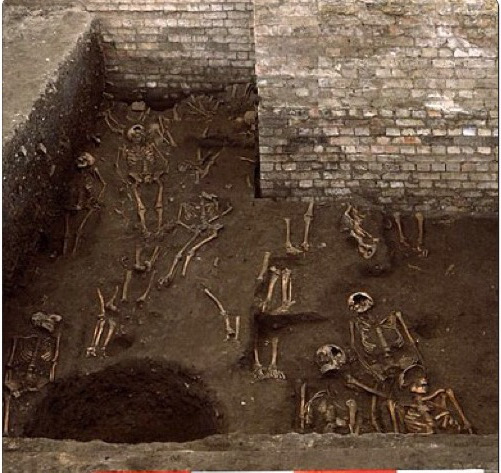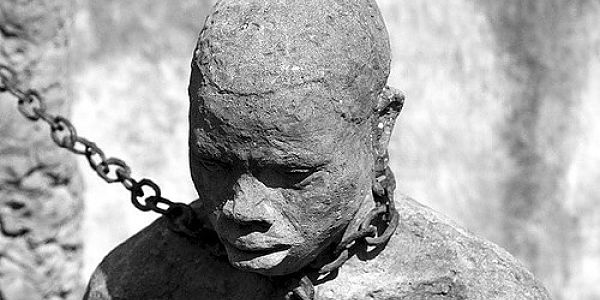Examples of Projects with Dorthy Garrod Laboratory participation:
After the Plague: Health and History in Medieval Cambridge
The Plague of 1348-1350, known as the Black Death, is estimated to have killed up to half of the European population, yet we still do not fully understand the social and biological effects of this devastating event. Unanswered questions include: how did standards of living change after the Black Death? What were the biological consequences of the Black Death? Were these changes minor and short-term or did they have lasting consequences? To address these questions, the collaborative ‘After the Plague’ project, funded by the Wellcome Trust and led by Professor John Robb, utilises multiple lines of evidence to compare health and lifestyle before and after the Plague. The project is focussed on Medieval Cambridge, where skeletons from the Hospital of St John, dating from c.1200-1511, form the core sample. As part of the project, Alice Rose, supervised by Dr Tamsin O’Connell and Dr Susanne Hakenbeck, is using isotopic analysis of archaeological skeletal material from Cambridge to understand how diet and mobility changed through time, particularly during the 14th century.
The Chemistry of Christianisation: A Multi-Factorial Study of Conversion Period Anglo-Saxon Cemeteries
This project’s main aim is to investigate changes in diet and burial practice during the 7th century Anglo-Saxon conversion to Christianity. It will compare several Anglo-Saxon cemeteries utilizing C & N stable isotope analysis alongside funerary archaeology.
FOGLIP: Food Globalisation in Prehistory
Each of today's major food species is distributed worldwide. While much of that food  globalisation has resulted from modern trade networks, it has its roots in prehistory. By the end of the second millennium BC, the south west Asian crops, wheat and barley, were in several parts of China, and Chinese millets and buckwheat were in Europe. As part of this project, based in Cambridge and led by Prof Martin Jones, Dr Emma Lightfoot is using a variety of stable isotope methodologies to investigate the spread of farming across Eurasia in the Neolithic and Bronze Age. These include: oxygen isotope analysis of modern and archaeological sheep teeth to investigate how climate change affected the spread of agriculture through the crucial crossroads of Central Asia; published carbon isotope studies to investigate millet consumption across Eurasia in prehistory; carbon and nitrogen isotope analysis to investigate dietary diversity in Bronze Age pastoral societies in central Kazakhstan; and plant growth experiments to investigate the variation in carbon and nitrogen isotopic values of different varieties of millet (Setaria italica).
globalisation has resulted from modern trade networks, it has its roots in prehistory. By the end of the second millennium BC, the south west Asian crops, wheat and barley, were in several parts of China, and Chinese millets and buckwheat were in Europe. As part of this project, based in Cambridge and led by Prof Martin Jones, Dr Emma Lightfoot is using a variety of stable isotope methodologies to investigate the spread of farming across Eurasia in the Neolithic and Bronze Age. These include: oxygen isotope analysis of modern and archaeological sheep teeth to investigate how climate change affected the spread of agriculture through the crucial crossroads of Central Asia; published carbon isotope studies to investigate millet consumption across Eurasia in prehistory; carbon and nitrogen isotope analysis to investigate dietary diversity in Bronze Age pastoral societies in central Kazakhstan; and plant growth experiments to investigate the variation in carbon and nitrogen isotopic values of different varieties of millet (Setaria italica).
Literary Archaeology: Exploring The Lived Environment of the Slave
Between the 16th and 19th centuries it is estimated that 12 million  people were captured as slaves or sold into slavery in a trade that took them from their homes in Africa to plantations in the Americas. Despite having been much studied and debated, the slave trade continues to provoke intense academic and public interest because there is still so much we do not know about slavery. As part of this project, Dr Emma Lightfoot is collaborating with Dr Josie Gill (Bristol), Dr Catriona McKenzie (Exeter) and creative writers to explore what it was like to be enslaved. Both scientists and humanities scholars have attempted to understand this experience: archaeologists examine the physical human skeletal remains of the enslaved, uncovering details about the birth place, health, well-being and traumatic injuries sustained by the slaves. In contrast, writers combine existing historical information with their own imaginative impulses to represent individual experiences of slavery. While archaeologists' and writers' aims are similar, their methods are different. We aim to begin a dialogue between these groups, to explore how literary and archaeological narratives of slave lives might influence and inform one another to improve our understanding of what it was like to be a slave.
people were captured as slaves or sold into slavery in a trade that took them from their homes in Africa to plantations in the Americas. Despite having been much studied and debated, the slave trade continues to provoke intense academic and public interest because there is still so much we do not know about slavery. As part of this project, Dr Emma Lightfoot is collaborating with Dr Josie Gill (Bristol), Dr Catriona McKenzie (Exeter) and creative writers to explore what it was like to be enslaved. Both scientists and humanities scholars have attempted to understand this experience: archaeologists examine the physical human skeletal remains of the enslaved, uncovering details about the birth place, health, well-being and traumatic injuries sustained by the slaves. In contrast, writers combine existing historical information with their own imaginative impulses to represent individual experiences of slavery. While archaeologists' and writers' aims are similar, their methods are different. We aim to begin a dialogue between these groups, to explore how literary and archaeological narratives of slave lives might influence and inform one another to improve our understanding of what it was like to be a slave.
The Effects of Endemic Warfare on the Health of Historic Period Populations from Croatia
 Warfare has afflicted humankind throughout its history, and is a phenomenon that still fundamentally affects the modern world. Despite the fact that violence-related mortality is profoundly undercounted, violent conflict represents a worryingly high source of mortality around the world. Recent history has seen a fundamental change in the nature of war with a marked shift from external to internal wars, a type of war characterized by low-intensity, endemic warfare that the international community is still struggling to develop the strategies and mechanisms to deal with effectively. Exactly this type of warfare is present in Croatia from 1400-1700 when the territorially aggressive Ottoman Empire establishes itself on Croatia's eastern borders. Analyzing the effects that war had on health through the deep time perspective that archaeological investigations afford can provide unique data on the interactions between warfare, health and the environment and provided conclusions that are particularly relevant to disadvantaged communities throughout the developing world where most wars are currently being fought. As part of this project, led by Prof. dr. sc. Mario Slaus (Croatian Academy of Sciences and Arts), Dr Emma Lightfoot is comparing diet and mobility of individuals dating from the Late Medieval period (1100-1400 AD, a period of relative prosperity and peace prior to the arrival of Ottoman Turks) to individuals dating to the Historic period (1400-1700 AD, during which time the Ottoman Empire gradually expanded into East and Central Europe) in order to consider the effect of endemic violence on the everyday lives of the inhabitants of the region.
Warfare has afflicted humankind throughout its history, and is a phenomenon that still fundamentally affects the modern world. Despite the fact that violence-related mortality is profoundly undercounted, violent conflict represents a worryingly high source of mortality around the world. Recent history has seen a fundamental change in the nature of war with a marked shift from external to internal wars, a type of war characterized by low-intensity, endemic warfare that the international community is still struggling to develop the strategies and mechanisms to deal with effectively. Exactly this type of warfare is present in Croatia from 1400-1700 when the territorially aggressive Ottoman Empire establishes itself on Croatia's eastern borders. Analyzing the effects that war had on health through the deep time perspective that archaeological investigations afford can provide unique data on the interactions between warfare, health and the environment and provided conclusions that are particularly relevant to disadvantaged communities throughout the developing world where most wars are currently being fought. As part of this project, led by Prof. dr. sc. Mario Slaus (Croatian Academy of Sciences and Arts), Dr Emma Lightfoot is comparing diet and mobility of individuals dating from the Late Medieval period (1100-1400 AD, a period of relative prosperity and peace prior to the arrival of Ottoman Turks) to individuals dating to the Historic period (1400-1700 AD, during which time the Ottoman Empire gradually expanded into East and Central Europe) in order to consider the effect of endemic violence on the everyday lives of the inhabitants of the region.
TwoRains: Winter Rain, Summer Rain: Adaptation, Climate Change, Resilience and the Indus Civilisation
Rainfall systems are complex and inherently variable, yet they are of fundamental importance for  understanding the past and planning for the future due to their potential for direct impact on food security and hence the sustainability of human settlement in particular areas. Given that human populations can adapt their behaviour to a wide range of climatic and environmental conditions, it is essential that we understand the degree to which human choices in the past, present and future are resilient and sustainable in the face of variable weather conditions, and when confronted with abrupt events of climate change. As part of this Cambridge-based project led by Dr Cameron Petrie, Dr Emma Lightfoot and Dr M. Cemre Ustunkaya are using stable isotope analysis of animal and plant remains to investigate the resilience and sustainability of South Asia’s first complex society, the Indus Civilisation (c.3000-1500 BC with an urban phase spanning c.2500-1900 BC). The Indus was unique amongst early civilisations in that it developed across a range of distinctive environmental and ecological zones, where the distribution of westerly winter rains overlapped with the rains of the Indian Summer Monsoon (ISM).
understanding the past and planning for the future due to their potential for direct impact on food security and hence the sustainability of human settlement in particular areas. Given that human populations can adapt their behaviour to a wide range of climatic and environmental conditions, it is essential that we understand the degree to which human choices in the past, present and future are resilient and sustainable in the face of variable weather conditions, and when confronted with abrupt events of climate change. As part of this Cambridge-based project led by Dr Cameron Petrie, Dr Emma Lightfoot and Dr M. Cemre Ustunkaya are using stable isotope analysis of animal and plant remains to investigate the resilience and sustainability of South Asia’s first complex society, the Indus Civilisation (c.3000-1500 BC with an urban phase spanning c.2500-1900 BC). The Indus was unique amongst early civilisations in that it developed across a range of distinctive environmental and ecological zones, where the distribution of westerly winter rains overlapped with the rains of the Indian Summer Monsoon (ISM).


